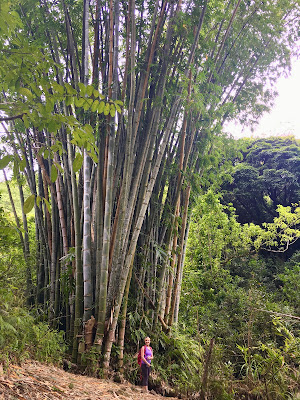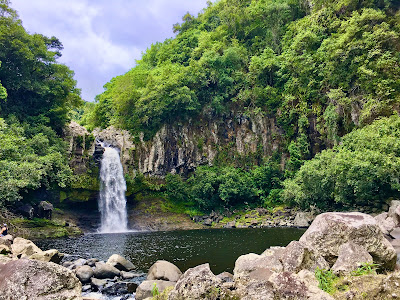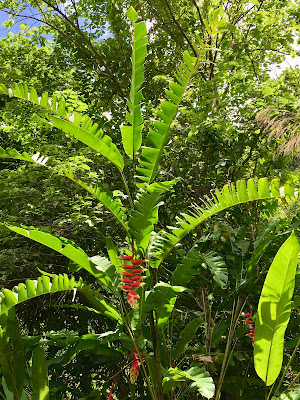Grand Bassin, in the south of Reunion Island, is sometimes nicknamed "Little Mafate" due to the fact that, like the cirque of Mafate, you can only access it on foot. Grand Bassin literally means "large pool" and is actually the name of the small village, while the nearby waterfall is called Voile de La Mariée (not to be confused with the more well-known waterfall of the same name in Salazie).
 |
view of Grand Bassin, waterfall and pool just visible to the left
|
There are several hiking paths to access Grand Bassin, but the most popular is the hike down from the Belvédère (look-out point) of Bois Court in the municipality of
Le Tampon. A
study between January and September 2017 found that Grand Bassin was Reunion's fourth most popular hiking path, with 79,537 passings during those nine months (bear in mind that a "passing" may be the same person walking there and back).
It actually took us about 2 hours to hike down to the village, but only 10 minutes more to hike back up the next day. The incline is quite steep as the elevation difference is about 700 metres over a distance of 4.5 kilometres. As you can see from the sign pictured above, the waterfall is about 30 minutes further on from the village.
 |
Grand Bassin seen from Bois Court
|
 |
looking north from near the village
|
Villagers used to earn their living from cultivating geranium and coffee but in recent years have increasingly turned to tourism. Last time I came to Grand Bassin in 2004 there were only three
gîtes if I remember rightly. Now there are at least nine! The gîte we stayed in was very welcoming and we were offered a free drink of tea or coffee on arrival. The evening meal was very copious and included some unusual ingredients such as chayote root and taro stem.
 |
looking inside the village chapel
|
Another difference compared to 2004 was increased awareness-raising about one of the world's rarest birds, the critically endangered
Mascarene Petrel, which is thought to nest high up in the surrounding mountains, (although the bird is so rare that no nest has ever been discovered). Known locally as the
timize, its otherwordly cries made the area's early inhabitants wonder if a monster lived in the mountains, and this gave rise to a number of stories and legends.
 |
possible petrel breeding sites?
|
Another endangered (as opposed to critically endangered) bird that lives in the surrounding mountains is
Barau's Petrel, known locally as the
tayvan or
taillevent. I translated and recorded the English voiceover of a documentary about it, which you can see
here.
 |
Grand Bassin beekeepers
|
After a good night's sleep and a filling breakfast we headed to the waterfall, passing some hives and beekeepers along the way.
 |
viewpoint over the waterfall before reaching it
|
 |
| main waterfall |
 |
main waterfall to the right
(and that's me behind the smaller waterfall to the left)
|
Afterwards, we headed back to the village where we picked up some sandwiches we'd ordered before the hot and dusty slog back up to Bois Court!
 |
| the way back! |
See also:
You might also like:























































